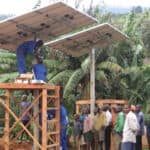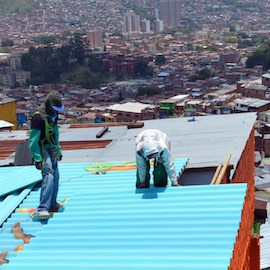Beyond Illumination: An Off-Grid Energy Provider in Indonesia Innovates to Maximize the Impact of Solar Home Systems
Gazing upon the breathtaking landscape of the Indonesian archipelago, the beauty of the 18,000 scattered islands is undeniable. However, when viewed from above at night, there’s a striking contrast between the more populous islands in the west, which are dotted with clusters of electric light, and the dimly illuminated ones in the east. This contrast provides a stark reminder of the challenges faced by rural electrification in this vast nation.
Indonesia’s electrification rate is far from uniform: According to our market research at All Solar World, some islands enjoy almost 100% energy access, while others in the eastern region, particularly in East Nusa Tenggara, struggle at a mere 62%. In this article, I will explore the myriad obstacles hindering electrification in the east, and discuss how innovative solar home systems (SHS) are emerging as a transformative solution — not only to the lack of rural energy access, but to other development challenges as well.
Indonesia’s Daunting Electrical Infrastructure Challenge
Navigating the complex terrain of Indonesia’s islands is no small feat. The archipelago’s diverse geography includes everything from densely forested mountains to coastal plains, making the installation of conventional electrical infrastructure an arduous and costly endeavor. Remote and underdeveloped areas in East Nusa Tenggara are particularly challenging, where the lack of basic infrastructure, such as roads and bridges, compounds the difficulty of bringing electricity to these communities.
Traditional electrical grid extensions require substantial financial investments, including the construction of power lines, substations and transformers. The high upfront costs of this infrastructure, combined with the low population density in remote regions, dissuade local electricity providers from pursuing these projects, as the return on investment is often unfavorable. The ongoing maintenance of electrical infrastructure on these islands is also expensive, making it even more difficult for providers to justify such ventures.
The simple truth is that, for traditional electricity providers, there are more lucrative areas to invest in. With these companies’ limited financial resources and their need to prioritize profitable regions, it’s easy to understand why remote, less-populated islands are often left in the dark, without access to the essential services that electricity can provide.
All Solar World’s SHS: A Brighter Future
Enter All Solar World, a company whose mission is to empower these remote Indonesian communities through innovative energy solutions. In pursuing this mission, we recognized that conventional methods of electrification — like extending the traditional power grid, using diesel generators or mini-grids, and cabling from island to island — might not be viable in these regions. We knew we had to come up with an innovative solution for this problem, so we developed a unique take on the solar home systems that are commonly used to reach off-grid communities. As a pioneering provider in the field, founded in 2014 with an initial focus on the sub-Saharan African market, we believe this approach offers a glimmer of hope for Indonesia’s underserved communities.
SHS is a game-changing technology that sidesteps the need for extensive electrical infrastructure by utilizing solar power. This approach makes clean, renewable energy accessible to the most remote corners of emerging markets like Indonesia. One of the most compelling benefits of this energy access is that it replaces kerosene lamps, which not only pollute the environment but also pose significant fire hazards. By providing clean solar lighting, we contribute to both environmental sustainability and improved safety for these communities.
But the uses of solar home systems extend far beyond just illumination, and our approach to developing and disseminating this technology enables us to maximize its multifaceted impacts in the communities we serve.
Bringing Connectivity with Wi-Fi Integration
One of the key ways we’ve taken this technology a step further is by integrating Wi-Fi modems into our SHS. Our modems use a unique patented Cloud-SIM technology provided by our partner uCloudlink, which doesn’t depend on the SIM cards that are typically required for mobile devices to connect to the internet. The modems connect to the strongest GSM signal available in the area, regardless of the network provider: uCloudlink has contracts with all major network providers in over 140 counties, and it facilitates these connections entirely for end-users. So our customers have no need for individual contracts with network providers, greatly simplifying the process of getting online. End-users are provided with 1GB of free data per month, and are charged a small fee based on how much additional data they use — but most of this expense is subsidized by sponsors like corporate social responsibility initiatives and other donation programs.
This added feature transforms these systems into not just sources of light but also gateways to online connectivity. With access to the internet, the remote communities we serve can now tap into a world of knowledge and opportunity. The Wi-Fi connection opens doors to education, online medical care and access to fair trade prices for local products — and even enables people to explore opportunities for small online businesses.
In a world where access to information is key, Wi-Fi-enabled SHS have the potential to bridge the gap between isolated communities and the broader global community. Though there is mobile network coverage in most of these remote areas, the devices used by many consumers are usually older mobile phones that cannot provide a good online experience, while newer devices are too expensive for them to buy in the absence of decent credit facilities. Additionally, without electricity it’s hard to keep these devices charged — something our SHS addresses through a built-in USB charging port. Our newest SHS model also comes with an integrated tablet, along with multiple USB charging ports. Through these innovations, our SHS offer a lifeline for these previously disconnected regions, bringing them the many benefits of the digital age.
Microfinance and Clean Lighting Accessibility
But Wi-Fi isn’t the only innovation we’ve adopted to increase the impact of our SHS products. For those living in remote areas of Indonesia, financial hardship often stands in the way of acquiring even the most basic necessities, such as clean lighting. Recognizing this, we partnered with microfinance institutions (MFIs) to make the SHS accessible, through financial inclusion, to the less fortunate and more financially underserved members of these communities.
To ensure that these vulnerable customers avoid the risks of formal borrowing, we work with local MFIs and banks that have experience in delivering microfinance to remote communities. We only work with financial services providers that offer competitive interest rates (a maximum of 8-12% per year). Even with this interest included, customers pay the same amount of money they previously spent on kerosene each month, and they are able to pay the SHS off in under three years — during which the SHS remains under our three-year warranty. We’ve written a clause into our contract with our partnering MFIs stipulating that the payback needs to be flexible, in case (to take one example) a harvest is unsuccessful. This gives customers the option to pay through reduced installments, switching to a longer payback time. We’ve taken these measures to avoid the risks caused when SHS customers are charged excessive interest rates that force them to continue paying for products even after those products no longer function — a problem that has emerged among some PAYGO SHS providers in Africa.
Responsible access to small loans from microfinance institutions makes clean lighting (and internet access) available to a wider range of people in remote areas. This not only improves their quality of life, it also empowers them economically. These customers become “bankable,” opening their access to other types of financial services. And as these individuals repay their loans, they build a credit history, opening the door to more substantial microloans that can be used to finance a small business or enable the purchase of income-generating assets.
Empowering Women
There’s one more way we’re working to expand the impact of our SHS products — one we take particular pride in: our Women Empowerment Program. The program focuses on increasing the number of local female sales agents we hire to help disseminate our products.
The majority of our sales agents are women, and we provide them with sales training, product knowledge and support from team leaders covering each geographical location we serve. We pay agents both salary and commission, and the commission payments from the sale of just six SHS per month are equivalent to the minimum salary in their region. This payment structure provides them with a great opportunity to earn an income that’s well above the local standard, and even to generate the starting capital for a small business or other future endeavor.
These local agents play a pivotal role in bringing our innovative products to Indonesia’s rural and remote markets. The female agents’ local cultural knowledge helps them tremendously in marketing SHS products to these rural communities, benefiting our business. And our training program provides agents with the knowledge and confidence they need to become successful salespeople who are better able to provide for their families. So the program not only provides employment to these often-marginalized women, it also fosters their economic independence and leadership skills.
Finally, despite the fact that traditional gender roles may limit opportunities for rural women, these communities are very welcoming to our agents. Many people in these villages are happy to see their fellow locals having a direct positive impact on their community — and those who buy an SHS from these agents are typically very pleased with the product and its impact on their household, further adding to the goodwill.
Conclusion
The challenges of rural electrification in Indonesia’s vast island archipelago, particularly in East Nusa Tenggara, are undeniable. The high costs and logistical challenges associated with conventional infrastructure development, coupled with the reluctance of local electricity providers to invest in these markets due to cost-effectiveness concerns, have left many communities in the dark.
While the emergence of solar home systems offers a groundbreaking solution to these challenges, this solution can also be the entry point for further innovation that can build upon the already-substantial impact of these products. Through this innovation, SHS technology can not only make clean solar lighting accessible to the most remote areas, replacing hazardous kerosene lamps, it can also provide a gateway to connectivity through integrated Wi-Fi. Meanwhile, partnerships with microfinance institutions can ensure that even the less fortunate have access to this transformative technology, while also making them bankable and creating opportunities for their financial empowerment. And by including women in the sale and dissemination of these products, their impact can extend beyond customers’ households to also include traditionally underserved individuals and communities.
By leveraging these interlocking innovations, solar home systems can become not just a source of vital light and energy, they can transform lives in the darkest corners of the nation, while building a sustainable future for all.
Hanko Scheffers is Chief Operating Officer at All Solar World.
Photo courtesy of Aziz Ainun Najib.
- Categories
- Energy, Technology



